This design was first done by Oeij Kok Sing, but made again by her daughter Jane Hendromartono, she included often tiny fish
First room in the exhibition ‘Batik Nyonyas’ highlighting batiks from the end of the 19th century, beginning 20th century made in Pekalongan
Build up of exhibition ‘TAMBAL’ at aNERDgallery
After a full week, I headed on 16 July to Singapore by bus for the weekend. Since I am making an small exhibition there that will open 22 August at aNERDgallery, I wanted to leave some of the stuff I already gathered & brought, there. Also to relax a little bit before going further and to finally see the Batik Nyonyas exhibition.
I arrived in after a quick busride and had a nice easy evening & morning. After some much needed social media updates, I headed out to aNERDgallery. Just to hang out and say hi. Also the artist Adel Ng was coming in to set-up the current exhibition, Tambal, inspired by the quilted blankets her grandmother made, the tambal motif in Batik & her own slow-fashion upcycle brand Muta Wear. She will be aNERDhost, while Tony is on Java, mostly with me.
Adel Ng upcycle station at aNERDgallery
Detail of quilted blanket of Adel Ng grandmother
In the early evening I headed to the Batik Nyonyas talk held at ACM, Modernity Unseen, The Free-Spirited Batiks of Nyonya
Oeij Soen King and Her Contemporaries from the North Coast of Java
I booked the bus a day earlier to catch this talk. When I found out the program, I knew I would be in my feelings. In my hurt feelings, but it was also very surprising!
The evening luckily also brought me to textile friends, which whom I had a nice dinner after with much to discuss on the talk & exhibition.
Oeij Soen King and Her Contemporaries from the North Coast of Java
I booked the bus a day earlier to catch this talk. When I found out the program, I knew I would be in my feelings. In my hurt feelings, but it was also very surprising!
The evening luckily also brought me to textile friends, which whom I had a nice dinner after with much to discuss on the talk & exhibition.
Peranakan Museum in Singapore
The fine mesh showing up on the photos,
with a little creativity I was able to get okay photos
Next day I finally got to see the exhibition ‘Batik Nyonyas’. Made 800+ photos, normally it would be 100 or so, let’s say I felt really inspired. But also made so many because how it is displayed behind a very fine mesh makes it difficult to take pictures. Deliberate or to protect it, unclear, but I was pretty determined to get details. Who knows when these will be on display again and if I ever get acces to them.
The exhibition tells the story of three generations of batikproducers in Pekalongan on Java in Indonesia, Nyonya Oeij Soen King, her daughter-in-law Nyonya Oeij Kok Sing, and her granddaughter Jane Hendromartono. The first generation started at the end of the 19th century, while the third and last work until 1980’s. The batiks and other objects in the exhibition were kept by the three daughters of the last one. These daughters also provided extra information & stories, which is also shown in a video interview with them. This extra layer, with stories on production, preserverende and clear provenance makes this exhibition pretty unique. How wonderful I get to chance to actual visit.
One of the earlier organized talks, was with them too. A much watch the video on Youtube ‘Three Nyonyas and an Esteemed Collaborator: Family Memories of Batik Making in Pekalongan’
The exhibition tells the story of three generations of batikproducers in Pekalongan on Java in Indonesia, Nyonya Oeij Soen King, her daughter-in-law Nyonya Oeij Kok Sing, and her granddaughter Jane Hendromartono. The first generation started at the end of the 19th century, while the third and last work until 1980’s. The batiks and other objects in the exhibition were kept by the three daughters of the last one. These daughters also provided extra information & stories, which is also shown in a video interview with them. This extra layer, with stories on production, preserverende and clear provenance makes this exhibition pretty unique. How wonderful I get to chance to actual visit.
One of the earlier organized talks, was with them too. A much watch the video on Youtube ‘Three Nyonyas and an Esteemed Collaborator: Family Memories of Batik Making in Pekalongan’
The three daughters
Old photographs of the batikworkshop shared in the video
The first generation brings some confusion. The sisters say all were made by their greatgrandmother Nyonya Oeij Soen King, but she didn’t sign and all are very different (sounds familiar..). The choice, or belief, to present this pieces all by her, makes for a difficult story to tell. Previously research has been done on the cotton, colour & dye use to determine if one maker could be identified (and now..?). In the catalog was mentioned:
“A common assumption is that an individual batik workshop would stick to a consistent dyeing practice that differed from other workshops. This was purported in a study by Proaño Gaibor et al., the first technical study of batiks, which concluded that Franquemont's batiks originated from different workshops because of the different dyes identified. However, the present study has shown otherwise.
By including signed batiks of different makers in comparison to Oeij's, the results revealed a wide range of cotton fabric and different dyestuffs for the reds of all four batik makers, without showing a systematic relationship to the maker.”
“A common assumption is that an individual batik workshop would stick to a consistent dyeing practice that differed from other workshops. This was purported in a study by Proaño Gaibor et al., the first technical study of batiks, which concluded that Franquemont's batiks originated from different workshops because of the different dyes identified. However, the present study has shown otherwise.
By including signed batiks of different makers in comparison to Oeij's, the results revealed a wide range of cotton fabric and different dyestuffs for the reds of all four batik makers, without showing a systematic relationship to the maker.”
Attributed to the first generation, Oeij Soen King
Photo-album gifted to Jasper with enlarged photograph of the ‘jaarmarkt’ exhibition behind it
Snowwhite batik detail, Batik signed by ‘L.Metz’
But my research was based on the specific story that the green used by Von Franquemont was her own unique invention, and therefor we researched all the colours including the green to find out they were all dyed differently, apart from the green that was done all the same in a not secret or special way, but with the oldest dye method known to create green in batik... (read full report here link ) So let’s say their conclusion on our study being wrong, and in fact we conclude the same, is so odd.
During the talk I attended the night before, the researchers explained they could not prove the batiks were made by one person or workshop. (Yes..). And did not claim they were all from the same maker. They also shared they misidentify their secret colour red and a new version of the catalog will be made. Hopefully they will rewrite their conclusion too, I hope.
During the talk I attended the night before, the researchers explained they could not prove the batiks were made by one person or workshop. (Yes..). And did not claim they were all from the same maker. They also shared they misidentify their secret colour red and a new version of the catalog will be made. Hopefully they will rewrite their conclusion too, I hope.
Display on introduction of synthetic dyes to the batik industry
From Nyonya Oeij Kok Sin's album, 1940s-1950s
Sarongs by Nyonya Oeij Kok Sing and Jane Hendromartono,
above signed by Jane in 1967,
sarong below stamped by Oeij Kok Sing, 9 september 1941
For me the main question is, why go through all this afford to present these 18 batiks from one workshop? Wouldn’t it raise more interesting findings if the questions are, were are these batiks from? What are all the differences & what are the similarities? Was she indeed a batikmaker, or could some be her wardrobe or was she perhaps a reseller? I wonder right away, are there marks of wear, or details to link it to other pieces with a clear provenance.
Anyway, the first section of the exhibition had for me very wonderful signed batiks including one with Snowwhite. It also has an album I would love to get my hands on, a photo-album gifted to Jasper in 1923 to celebrate his annual fair activities. Peter Lee shared some images during his talk and luckily some were used enlarged in the exhibition. Fascinating!
Anyway, the first section of the exhibition had for me very wonderful signed batiks including one with Snowwhite. It also has an album I would love to get my hands on, a photo-album gifted to Jasper in 1923 to celebrate his annual fair activities. Peter Lee shared some images during his talk and luckily some were used enlarged in the exhibition. Fascinating!
Two hangings with a depiction of Mai Langfang, a Chinese Peking opera artist playing the role of Tiannu Sanhua doing the sleeve dance, left batik by Jane, right by Oeij Kok Sing
Batik by Jane Hendromartono from early 1950's
Batik left signed by J. Jans, 1900's, Batik right signed 'Nj. Oeij Kok Sing P.K.L.' and stamped
In the ‘Batik Nyonyas’ exhibition I connected most to the Batiks from the 19th century, probably because my research is focussed on this period in batik history, but felt another kind of strong connection to Jane Hendromartono story.
Sketch by Jane Hendromartono
Display of the cap items Jane Hendromartono produced
Batik by Jane Hendromartono with little fish detail
The story of Jane Hendromartono is probably the most detailed, since her daughters could re-tell, and certainly the most artistic. Jane experimented a lot, to keep up with fashion trends, market demands and her own interests.
It was nice that in this part we really get to know the maker, with early drawings, a childhood dairy in Dutch(!!), all kind of business items like stationary, cards. Jane also started producing cap next to her Batik Tulis pieces. The little cap that says ‘100% batik tulis’ took me out, technically the batik tulis would be 99,99% Batik Tulis if this tiny cap is used.
If her grandmother did make the variety the museum is claiming, Jane is indeed a testament to that story.
I especially liked the 70’s ready to wear section, with maxi skirts & belts, I want all! Especially the skirt in aquagreen!
It was nice that in this part we really get to know the maker, with early drawings, a childhood dairy in Dutch(!!), all kind of business items like stationary, cards. Jane also started producing cap next to her Batik Tulis pieces. The little cap that says ‘100% batik tulis’ took me out, technically the batik tulis would be 99,99% Batik Tulis if this tiny cap is used.
If her grandmother did make the variety the museum is claiming, Jane is indeed a testament to that story.
I especially liked the 70’s ready to wear section, with maxi skirts & belts, I want all! Especially the skirt in aquagreen!
The exhibition is an amazing celebration of these three generations and a reflection on the history they were part of. A must see, open till 31 August in Singapore!
Read more here on the exhibition: Interview with Peter Lee | “Batik Nyonyas: Three Generations of Art and Entrepreneurship" — Art of The Ancestors |
Island Southeast Asia, Oceania, and Global Tribal Art News
Hafiz showing his newly bought newly made chintz, including wax resist
Hafiz at aNERDstore heading out with his storytelling stuff
Hafiz Rashid's talk at One Punngolo
On Saturday I enjoyed a talk by Hafiz Rashid at One Punggolo about batik used as a medium for storytelling. Hafiz who is always dressed for the part of historical, fairytale & legends storyteller gave a presentation on the telling on stories to the writing down of stories. How in early books the text are highlighting to read out-loud. He used batiks from his own collection to invite the audience to do some storytelling themselves. It was really interesting to hear how they interpreted the batiks.
Currently I am on Java, I will update my blog & social media whenever I can & wifi allows me ;) ~ thank you for following my journey to Batik
Currently I am on Java, I will update my blog & social media whenever I can & wifi allows me ;) ~ thank you for following my journey to Batik


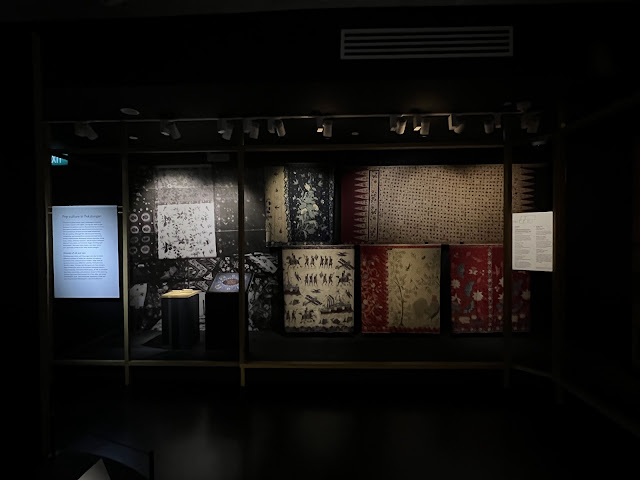







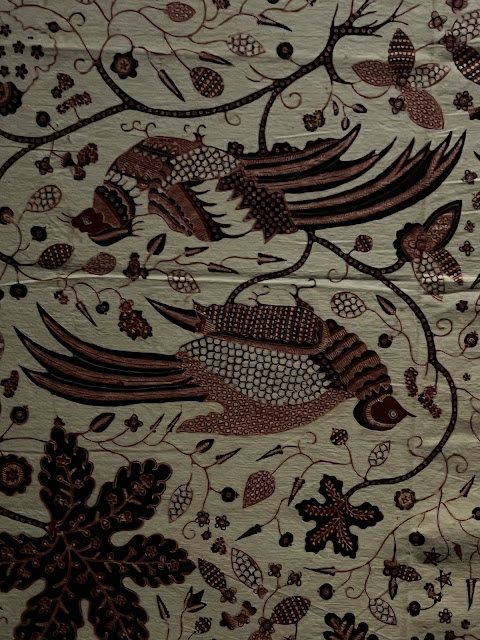








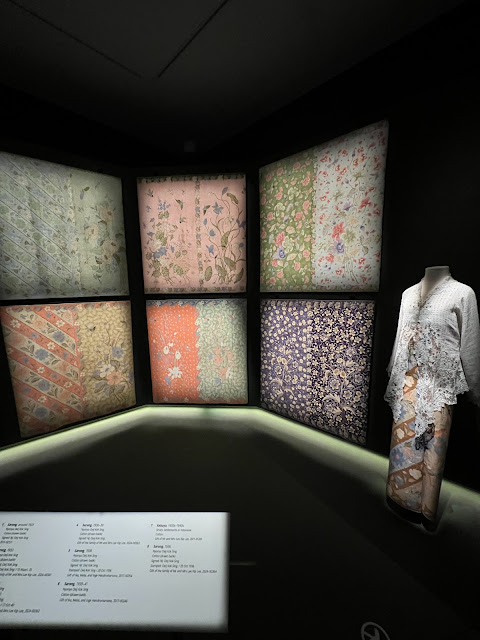
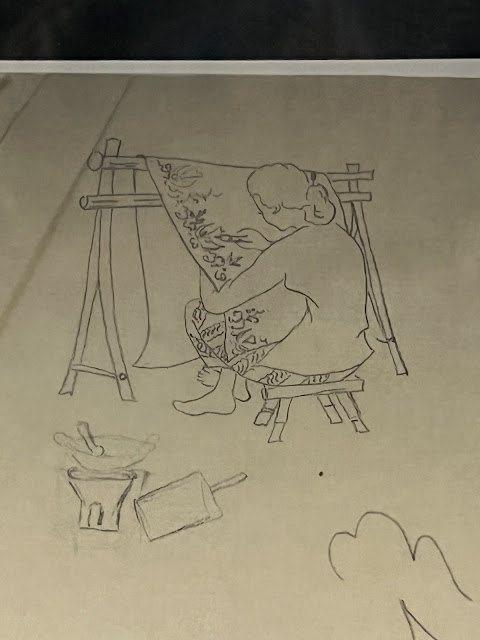







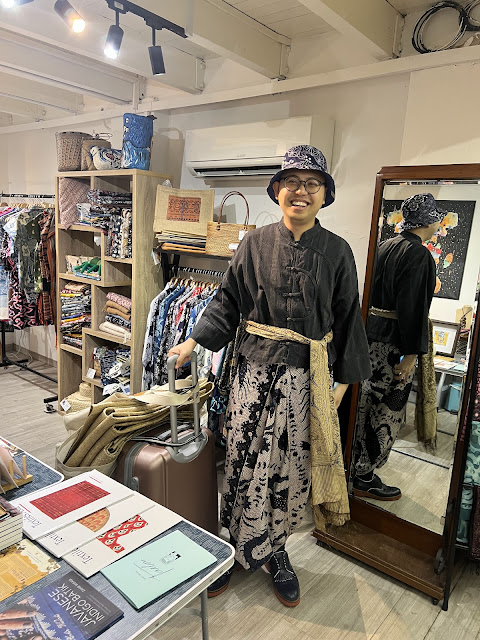


No comments:
Post a Comment